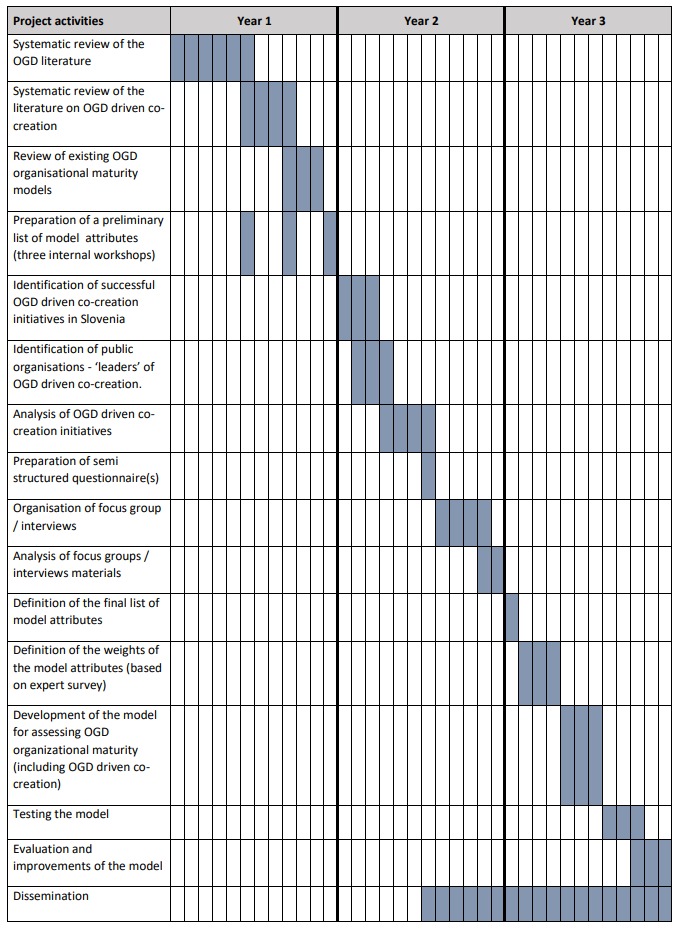Title: Open-Ready – an Evidence-based model for the assessment of organizational maturity for Open Government Data: a precondition for data driven cocreation (J5-50166)
Head of the research team: doc. dr. SanjaVrbek (1. 10. 2023 – 30. 9. 2026)
The project will develop an evidence-based model that supports public organisations in improving their capacity to successfully manage quality Open Government Data (OGD) and stimulate their (re)use in co-creative ways. It will be a decision support model for the assessment of OGD organisational maturity, including maturity for OGD driven co-creation. The urge for the project derives from the following observations:
1. OGD have enormous yet unused potential in terms of spurring innovation.
2. OGD by themselves do not have an intrinsic value – thus their sole publishing does not automatically translate into an impact on the ground.
3. Co-creation offers an effective way to activation of their potential with a wide-reaching impact.
Thus, at the heart of the problem, we recognise the lack of communication between the literatures on OGD and co-creation, as the two most promising solutions to the wicked problems of today. Although small steps have been made towards bridging these two concepts with the conceptualisation of the novel idea ‘OGD-driven co-created public services’, the focus has been completely placed on the service level. Therefore, we still lack an understanding of what makes public organisations capable, i.e., mature to capitalise on the synergy of OGD and co-creation. Although authors have endeavoured to understand OGD-driven co-created public services, mainly by process tracing their implementation in the context of multi-actor co-creation eco-systems, they have largely overlooked the question as to what makes a public organisation a constructive and successful partner within such an ecosystem.
The project addresses this gap by recognising public organisations as the key actors within such ecosystems and thus shifting the research focus on their organisational features/properties that make them apt not only to publish high quality OGD, but stimulate their (re)use in a co-creative manner. This decision rests on three main arguments implying that public organisations:
• cover the most numerous and important aspects referring to the management and reuse of OGD;
• have means and authority to make actual changes within their structure which can have a significant spill-over effect on the whole ecosystem; and
• have means (through different strategies and approaches) to stimulate and/or empower other actors of the ecosystem to overcome their barriers regarding OGD (re)use.
Hence, to achieve its goal and develop an advanced model for the assessment of OGD organisational maturity (including maturity for OGD-driven co-creation), the project relies on a systematic review of the OGD and OGD-driven co-creation literatures; review of existing OGD maturity models; empirical research within the Slovenian context and the AHP method. On this basis, the project develops a tool that provides:
1. A score of OGD organisational maturity (including maturity for OGD driven co-creation) – a general score and
subscores broken down according to a set of themes relevant to OGD.
2. Tailor-made recommendations for public organisations (based on their maturity score) to take strategic measures to improve their organisational standing in the area of OGD.
3. “What-if” analysis for easy identification of priority areas to be tackled, i.e., those that most significantly affect the OGD maturity score.
4. A basis for the creation of a national (Slovenian) benchmarking system for OGD maturity.
5. A basis for adaptation and application of the model to other countries sharing a similar context as Slovenia, i.e. (CEE) administrative tradition.
The model will be developed primarily for the Slovenian administrative environment. Instead of a limitation, this is rather an advantage as the Slovenian national context shares many features with other CEE countries. Since Slovenian public organisations face similar challenges as their CEE counterparts, this model will have great potential for easy adaptation and thus wide use within the CEE region (sharing similar administrative tradition).
Duration (from/to):
1. 10. 2023—30. 9. 2026
Contracting Authority:
Slovenian Research and Innovation Agency
Financing:
The project is being financed with 1286 yearly hours (A price category) for 3 years.

Project phases:

